Tuesday, December 11. 2012
Gradientizer - by fabric | ch and AMID.cero9
By fabric | ch
-----
Gradientizer is an architectural proposal for the New Planetarium and Natural Science Center buildings and program in Lausanne, Switzerland. It consists in the transformation of an old, almost rural and isolated settlement and the adjunction of two new buildings.
The proposal was completed early this year and was developed in close collaboration with Madrid based architects AMID.cero9 (Cristina Diaz Moreno and Efren Garcia Grinda, both also teachers at the Architectural Association in London).
We didn't win the "trophy" unfortunately, but as we believe nonetheless that the project is of interest, we take the opportunity to document and shortly present it on | rblg.

Gradientizer (excerpts from the competition text)
An architecture that articulates light, that pervades into the existing luminous gradients and albedos of the site, that transforms them on site, in plan and in section and which creates "dark poles", real "attractors" of the program: Planetarium, Solar room, Sky observation deck. A forgotten atmosphere, "almost unknown", but monitored nevertheless, built around the exposure of the program to light, in which visitors and scientists freely wander, layer by layer.
Monitored architecture of light gradients and albedos
The observation of the sky, by daytime and nighttime, is always marked by an intimate relationship with weather and light conditions. To make accessible the cosmos from Earth with the naked eye as through a powerful telescope, special conditions are needed: minimum cloud cover, low atmospheric density, maximum distance to the sources of artificial light at night.
Would we realize today a world map of the suitable observation locations, in continuous time, it would likely reveal a landscape in a vanishing phase, a kind of forgotten preindustrial relic. A sensual landscape that evolve along days and seasons: clear sky, starry dark night, low pollution, near low reflectance (albedo) lands.
It is this landscape, which has become almost unknown nowadays, that makes possible the observation of another one, fascinating and borderless: the cosmos. It is also precisely around this landscape that our project is built: a "gradient" architecture that seeks to analyze and transform the light patterns of the place, to inhabit them, which looks to generate and shape this "unknown landscape" and to comment it.
(...)

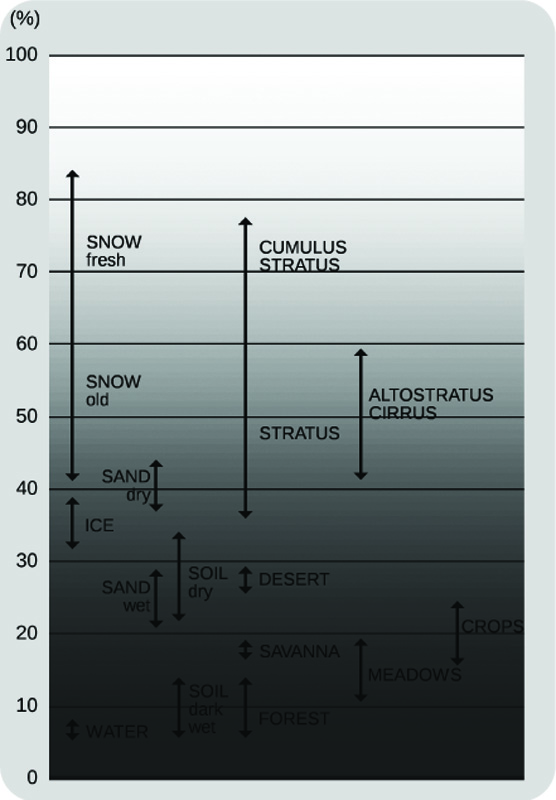

Expression of the light gradient on site at night (top image, the road axis are artificially lit, the rest of the site is dark --woods and grass land-- with the adjunction of a courtyard in the new project on the left image) and relation bewteen surfaces and albedo of surfaces (bottom image).
However, the site of the New Planterium has a light gradient of its own, with varying intensities: artificial illumination of roads at night, large farm like roofs that generate darkness during the day.
The project seeks to leverage this existing state, to develop it, whether it be in the positioning and association of functions in an almost generative way (rule based) or in the amplification of the roofs of the buidlings: to "gradientize" the overall site through its architecture.
(...)
To "gradientize" the site
Articulated around 4 main categories of exposure to light ("fully", "mostly", "partly" and "not at all" exposed), the program is distributed around the matching gradients of light on the site to achieve the initial distribution of functions. In section, this gradient is reinforced in order to create permanent "black areas" and to further distribute the program vertically.
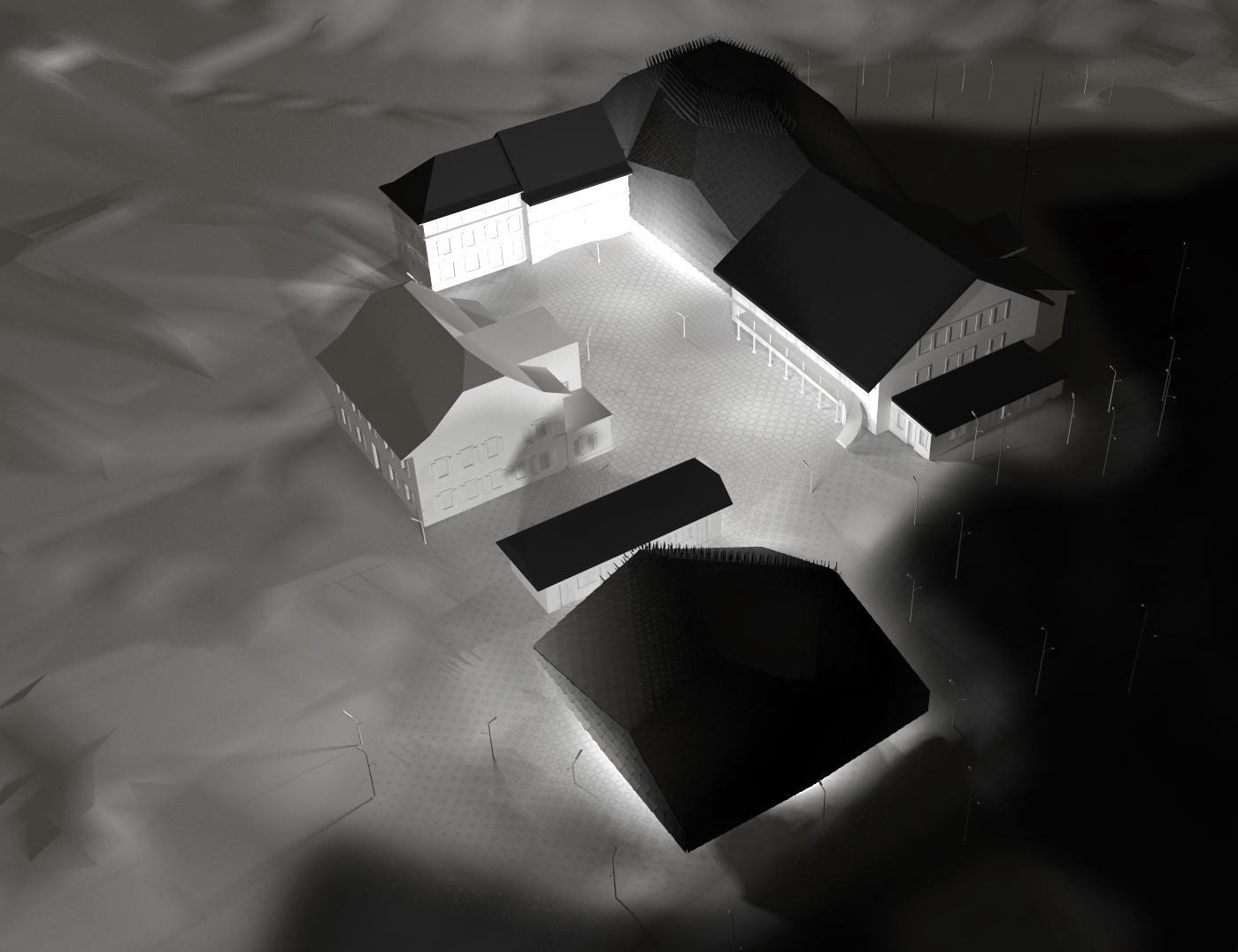
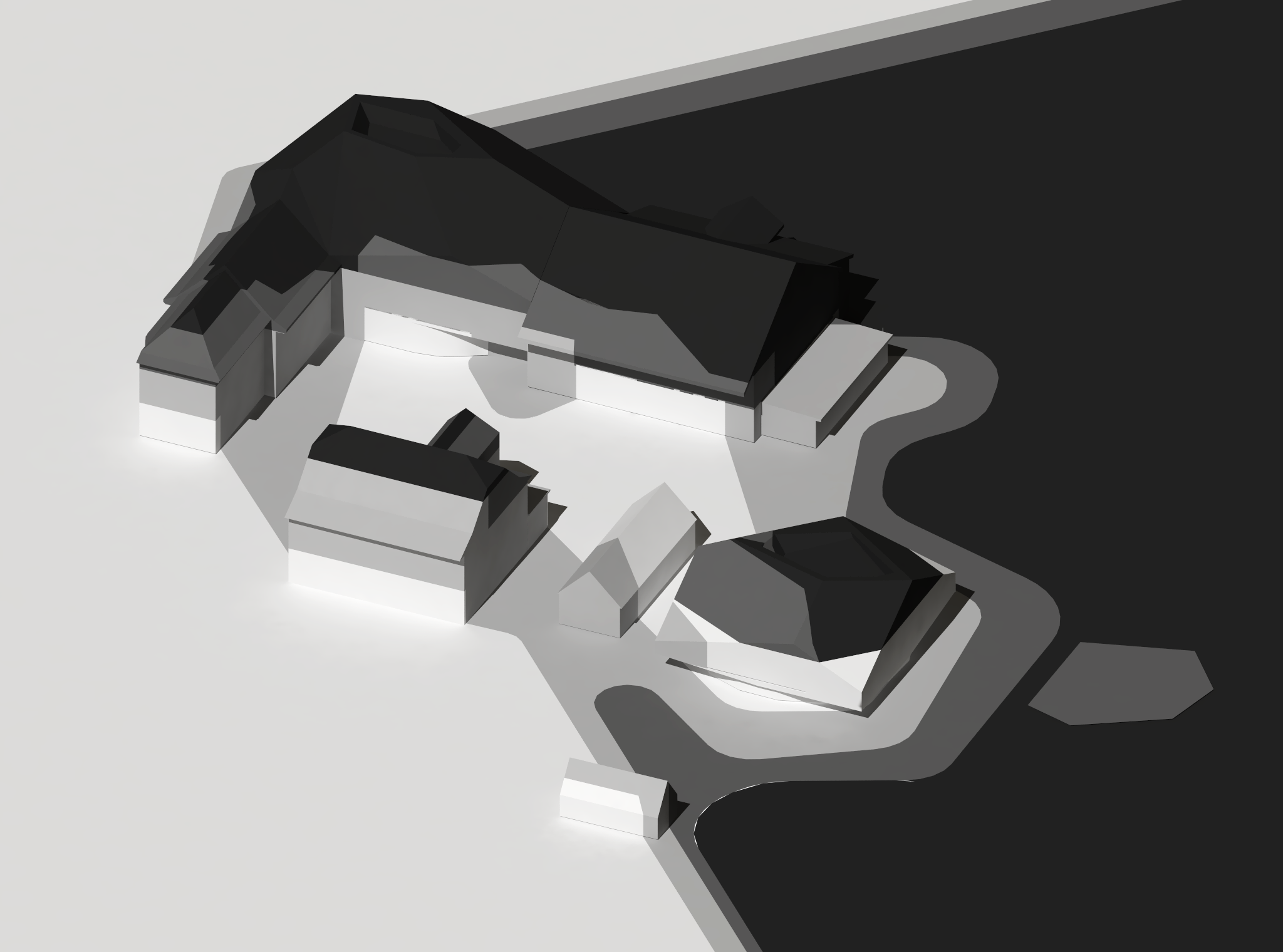
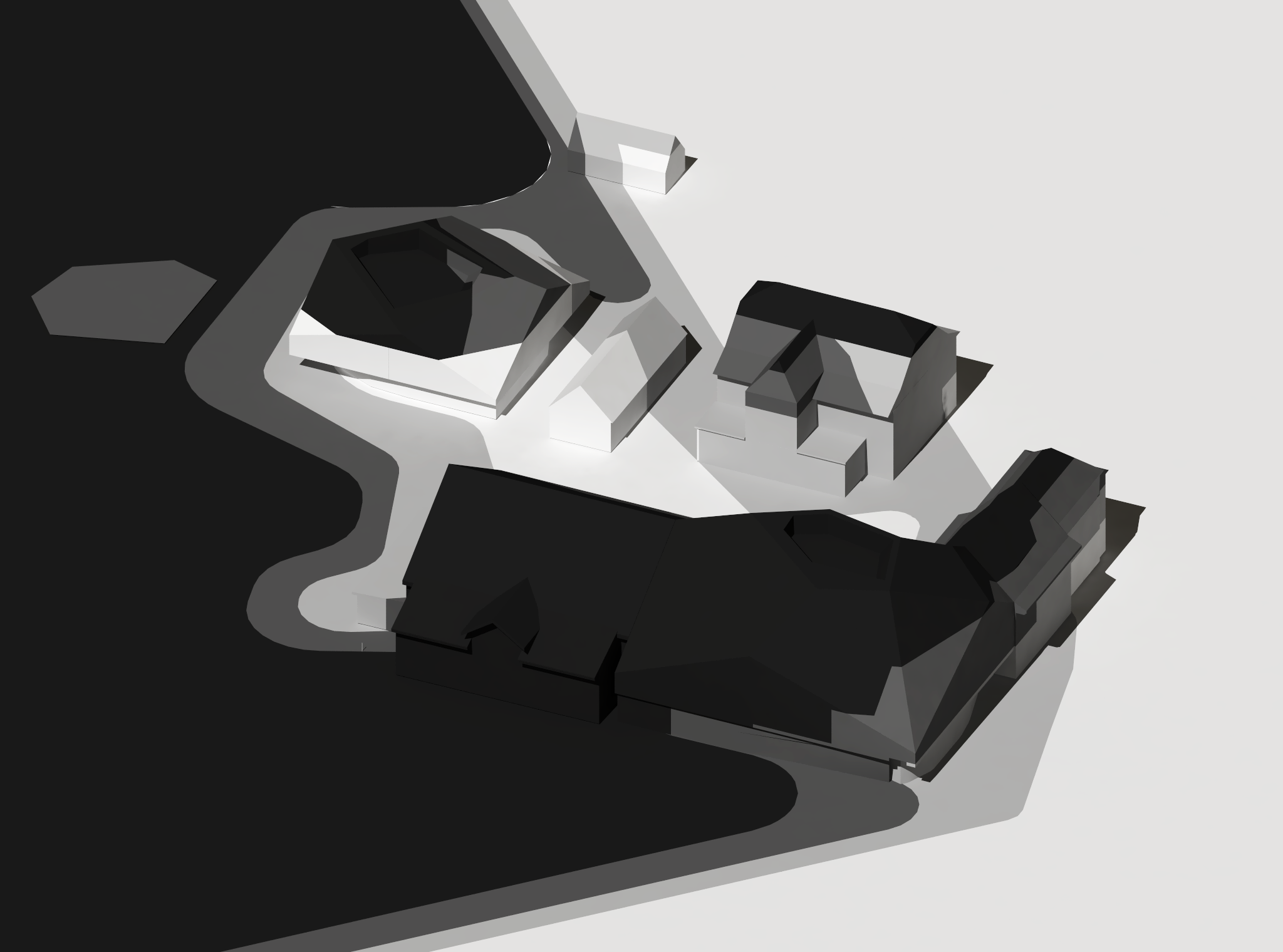
Expression of the light gradient on site and on the buildings (average value between the exposition to natural or artificial luminosity and the albedo of the surfaces).
White zone (fully exposed to light) along the roads axis, in the courtyard and around the ground levels that evolve toward the black zone (not exposed to light) on the east of the site and in the upper levels (roofs), through light grey (mostly exposed) and dark grey (partly exposed). The gradient on site serves us both as a way to locate functions and to choose materials or landscape treatments (according to their reflectance - albedo).


The program (surfaces, volumes and functions) of the New Planetarium and Natural Science Center dispatched according to its potential exposition to light, with the same 4 levels (fully, mostly, partly, not at all) as expressed on site.
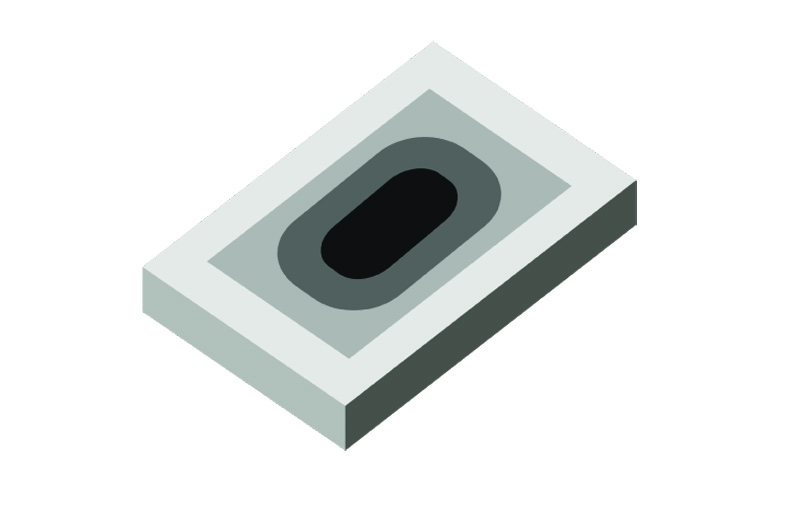
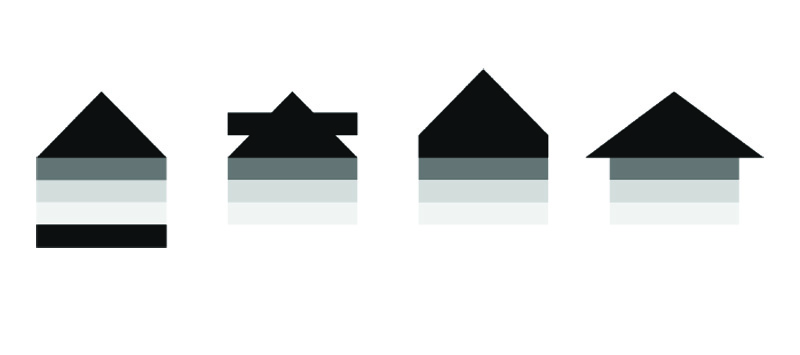
Schematic rules in plan and section to increase and deform existing lighting conditions (both natural and artificial): "onion" rings that filter light from the outside toward the inside in plan, suppression of basements that are moved into bigger roofs to progressively create drakness from botton to top levels.
Three main rules allow us to organize in this way the whole program of the New Planetarium and to outline its architecture. At night and in mass plan, the luminosity and reflectance gradient of the site evolves from lit perimeters, near traffic areas and roads, to dark areas towards forests and grassland (on the east part of the site, guaranteed to be kept in the future due to the reallocation of the whole area into a protected green park). The repartition of activities and functions on the site results mainly from this first rule (the program analysis based on its exposition to light). Thus, no artificial light is directed towards the east and south of the site at night. In plan, again but inside the buildings this time and mainly during day time, a concentric organization of volumes allow to filter and lower the light from the outside toward the inside. In section finally, during day time especially, large and deep roofs of agricultural characteristics also ensure the creation of shadows and darkness. No artificial lighting is installed in the dark grey or black areas.

The resulting axonometry of the project and principles of spatial organisation/uses according to the chosen set of rules.
This approach makes it possible to define principles of spatial organization, by day and night. This is the intention of the project: an architecture that fits into a monitored gradient of light proper to the site, which exploits but transforms its vocabulary of forms and materials, which deforms, amplifies and strengthens them, both in plan and section. These principles engender our architecture of spatial shifts, its main code. The result is the GRADIENTIZER.
(...)
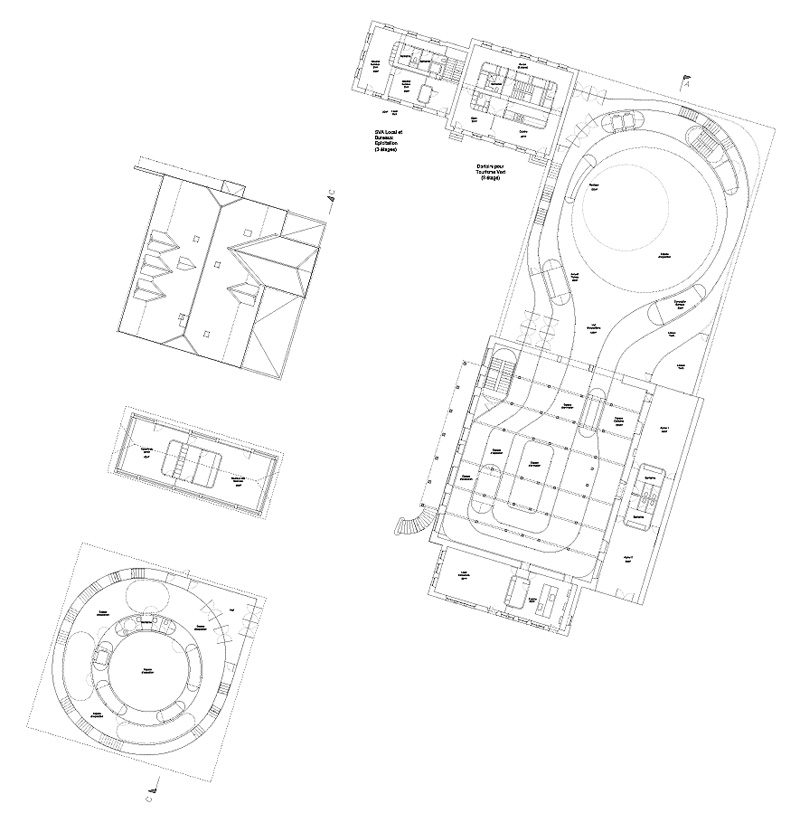
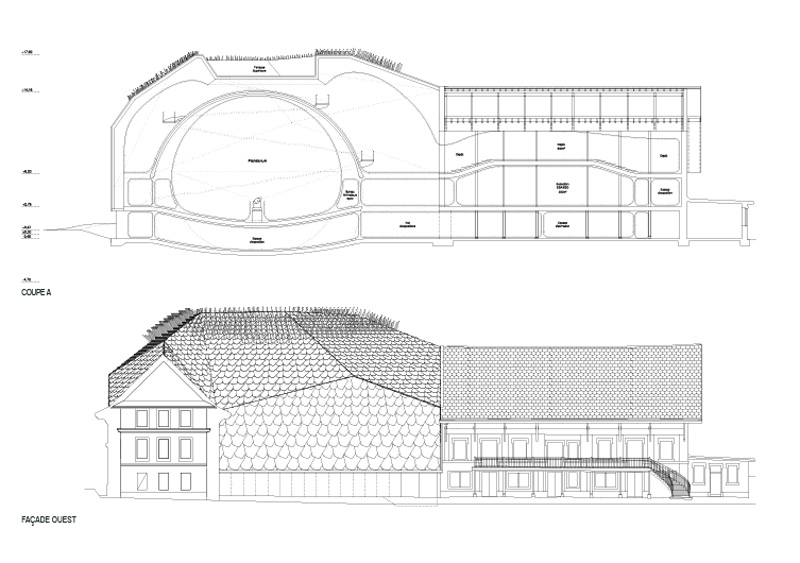
Planetarium, solar room, museum, hotel and eco-shop: ground floor plan and planetarium section, where the principles of organization in plan and section are applied.
Probes, sensors, monitoring, feedback loops and algorithms
A set of light and atmospheric probes equip the site and the interiors of the buildings. They are positioned so to reveal in first sight the average gradient on the site and to locate specific areas for the public (white, light grey, drak grey and black masts at different heights equiped with sensors that are positioned along the main lines of each gradient). Some also serve as furniture or lighting (white areas). These sensors continuously analyze the state of illumination of the Gradientizer and reveal it through freely accessible interfaces (both on site information displays, distributed over the Internet or through mobile apps) and feedbacks.
This constant analysis transcribes in "real time", along time and seasons, the variable state of a large architectural device based on simple rules (the exposition of the program to --monitored-- light). Custom and architectural algorithms indicate appropriate times to achieve a particular observation, shift of functions or activities in a conducive area.
(...)

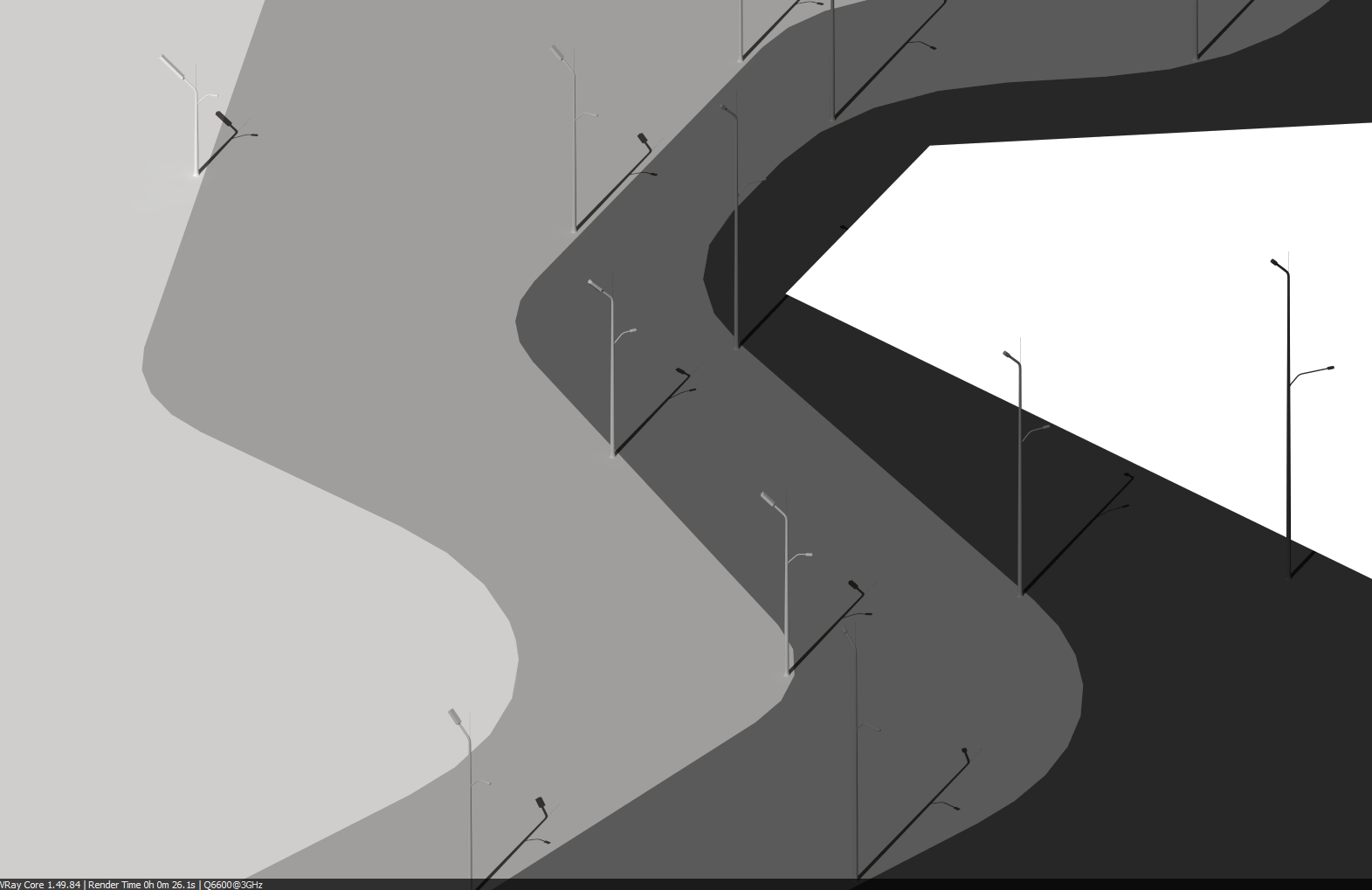
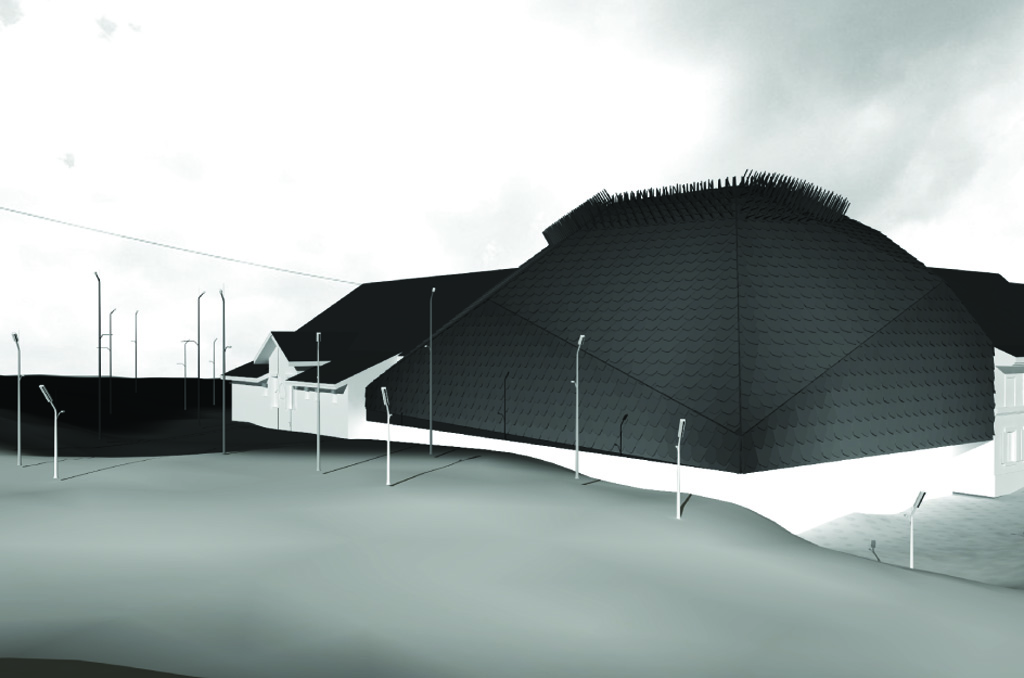
The position, orientation and design of the probes, made out of 4 different heights and that are coated in white, light grey, dark grey and black, reveal a first vision of the site's light gradient and surfaces albedo to the naked eye. They also serve to locate different activities (observation in the potential dark areas, public program in the white ones).
Darker than black (meta-material)
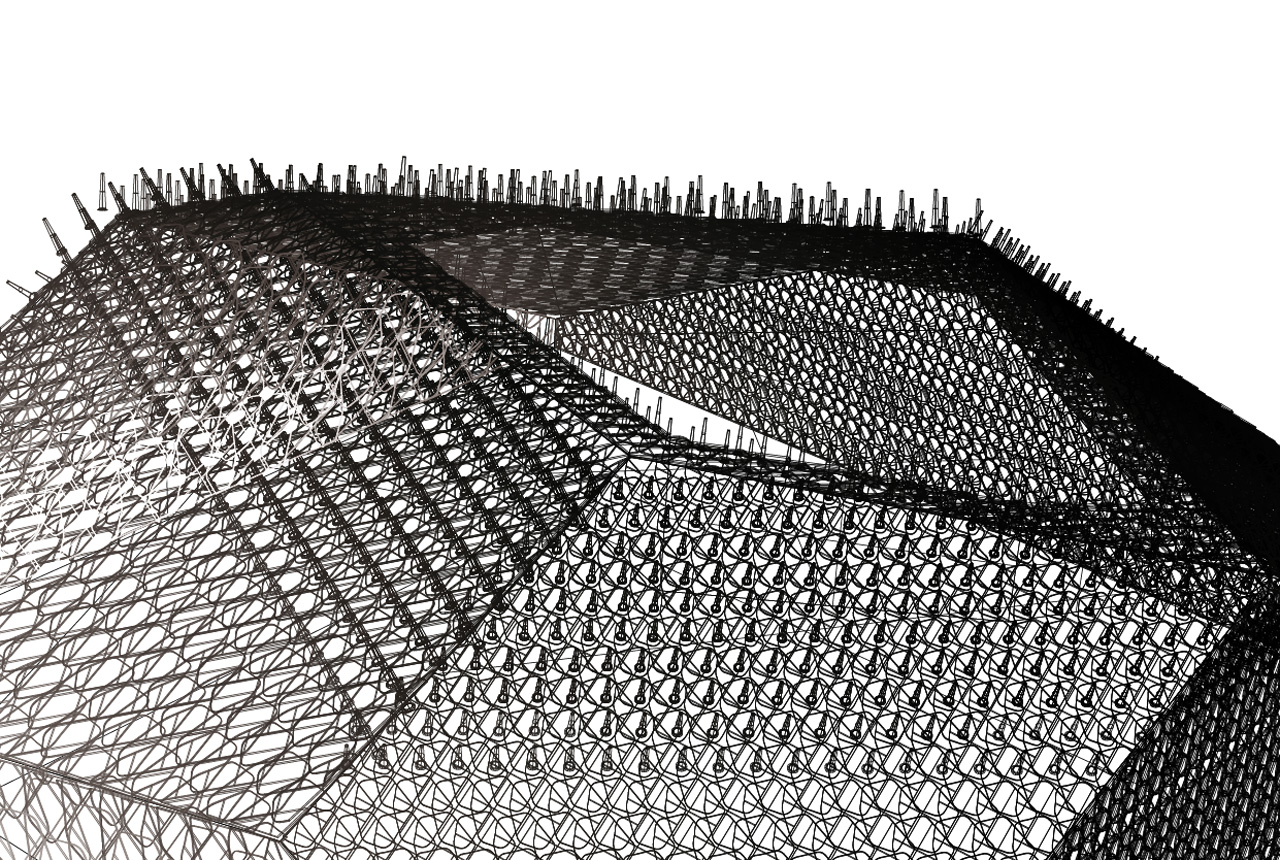
The upper levels of the new roofs (around the observation decks) are treated like “darker than black” meta-materials (see below), instead they are scaled about 10 billion times: a spiked surface within which incident lighting is getting reflected many times, loses its strength before eventually getting out. It can be considered as a similar process as what is happening in an anechoic chamber, but in this case for light instead of sound.

“Darker than black” metamaterials are nanoscale materials (that could also be used as coating) that trap the reflexion of light through very dark spiked surfaces. Therefore, the incident light is reflected a lot of time (at a tiny scale) before eventually getting out again. The light is "sucked" by the material and much less of it is reflected (only 1%).
Architecture as shifting landscape
.jpg)
The whole Planetarium and Natural Science Center can be seen and experienced as a light based architecture - landscape in constant evolution. It offers therefore oscillations, unpredictable spatial and uses variations. It suggests some sort of nomadic and evolving uses over time to adapt to the varying conditions.
A landscape that should be understood here in the sense of an environment with blurred limits, within which one can evolve with a certain freedom according to ones desires or needs. A landscape that "feels" its own variations and makes them visible, livable.
--------------------------------
Project: fabric | ch and AMID.cero9
Location: Lausanne, Switzerland
Team, fabric | ch: Patrick Keller, Christophe Guignard, Sinan Mansuroglu, Nicolas Besson
Team, AMID.cero9: Cristina Diaz Moreno, Efren Garcia Grinda, José Quintanar, Vicente Soler, Laura Migueláñez, Pei-Yao Wu
Partner: Computed·By (coding creative projects)
Related Links:
Friday, December 07. 2012
Apple Data Center Does Fuel Cell Industry a Huge Favor
-----
Apple doubles the size of the fuel cell at its new data center, a potential new energy model for the cloud computing.
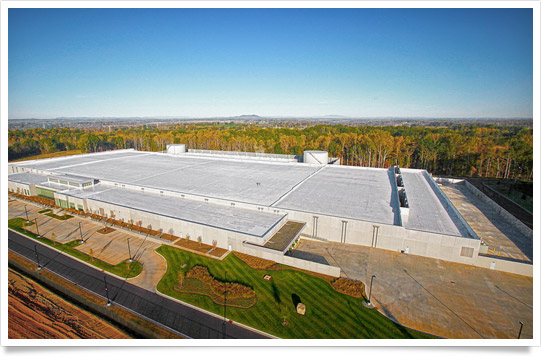
One of the ways Apple’s new data center will save energy is by using a white roof that reflects heat. Credit: Apple.
Apple is doubling the size its fuel cell installation at its new North Carolina data center, making it a proving ground for large-scale on-site energy at data centers.
In papers filed with the state’s utilities commission last month, Apple indicated that it intends to expand capacity from five megawatts of fuel cells, which are now runnning, to a maximum of 10 megawatts. The filing was originally spotted by the Charlotte News Observer.
Apple says the much-watched project (Wired actually hired a pilot to take photos of it) will be one of the most environmentally benign data centers ever built because it will use several energy-efficiency tricks and run on biogas-powered fuel cells and a giant 20-megawatt solar array.
Beyond Apple’s eco-bragging rights, this data center (and one being built by eBay) should provide valuable insights to the rest of the cloud computing industry. Apple likely won’t give hard numbers on expenses but, if all works as planned, it will validate data center fuel cells for reliable power generation at this scale.
Stationary fuel cells are certainly well proven, but multi-megawatt installations are pretty rare. Data center customers for Bloom Energy, which is supplying Apple in North Carolina, typically have far less than a megawatt installed. Each Bloom Energy Server, which takes up about a full parking space, produces 200 kilowatts.
By going to 10 megawatts of capacity, Apple can claim the largest fuel cell powered data center, passing eBay which earlier this year announced plans for six megawatts worth of fuel cells at a data center in Utah. (See, EBay Goes All-in With Fuel Cell-Powered Fuel Cell Data Center.) It also opens up new ways of doing business.
Using fuel cells at this scale potentially changes how data center operators use grid power and traditional back up diesel generators. With Apple’s combination of its solar power and fuel cells, it appears the facility will be able to produce more than the 20 megawatts it needs at full steam. That means Apple could sell power back to the utility or even operate independently and use the grid as back up power—a completely new configuration.
Bloom Energy’s top data center executive Peter Gross told Data Center Insider that data center servers could have two power cords—one from the grid and one from the fuel cells. In the event of a power failure, those fuel cells could keep the servers humming, rather than the backup diesel generators.
Apple hasn’t disclose how much it’s paying for all this, but the utility commission filing indicates it plans to monetize its choice of biogas, rather than natural gas. The documents show that Apple is contracting with a separate company to procure biogas, or methane that is given off from landfills. Because it’s a renewable source, Apple can receive compensation for renewable energy credits.
Proving fuel cells and solar work in a mission-critical workload at this scale is one thing. Whether it makes economic sense for companies other than cash-rich Apple and eBay is something different. Apple and eBay could save some money by installing fewer diesel generators. Investing in solar also gives companies a fixed electricity cost for years ahead, shielding them from spikes in utilities’ power prices.
But some of the most valuable information on these projects will be how the numbers pencil out. That might help conservative data center designers to look at these technologies, which are substantially cleaner than the grid, more seriously.
Both operationally and financially, there’s a lot to learn down in Maiden. Let’s hope Apple is a bit more forthcoming about its data center than telling us what’s in the next iPhone.
Personal comment:
This looks like one of several (but far not enough) implementations of "the third industrial revolution" (J. Rifkin), definitely a book to read to foresee a path toward a new (economic) model of clean energy and society, when the information based Internet will (might) combine with the energy based Internet and when energy will start to be an (abundant) solution and not a problem anymore.
We've seen computer/Internet industries take over the music industry, or now the book industry, etc. Will we see them take over the energy industry? We can witness several "little things" going into that direction. Google energy in your Google+ "task bar" by 2030?
But the main point of all this, is that if we by chance move not too late toward a clean energy model (fuel cells, solar, wind, etc.) --but note that we don't have any other choice now (an increase of 6°C degrees in average temperature means massive ecosystems extinctions by the end of the century, and will it or not, we are part of them--), it should remain decentralized and not concentrated as it is now. Therefore we should remain vigilant with this point like we are with the actual Internet. It is important that the system remains participative in some ways and that anybody can produce its own energy and share the surplus.
Tuesday, December 04. 2012
The Coldscape
Via Cabinet
-----
By Nicola Twilley
More than three-quarters of the food consumed in the United States today is processed, packaged, shipped, stored, and sold under artificial refrigeration. The shiny, humming stainless steel box in your kitchen is just the tip of the iceberg, so to speak—a tiny fragment of the vast global network of temperature-controlled storage and distribution warehouses cumulatively capable of hosting uncounted billions of cubic feet of chilled flesh, fish, or fruit. Add to that an equally vast and immeasurable volume of thermally controlled space in the form of shipping containers, wine cellars, floating fish factories, international seed banks, meat-aging lockers, and livestock semen storage, and it becomes clear that the evolving architecture of coldspace is as ubiquitous as it is varied, as essential as it is overlooked.
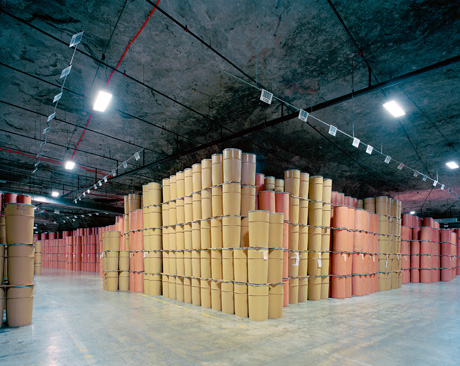
(...)
More about it and about a "perpetual winter" on Cabinet's website.
Related Links:
Electromagnetic Test Town
Via BLDGBLOG
-----
de noreply@blogger.com (Geoff Manaugh)
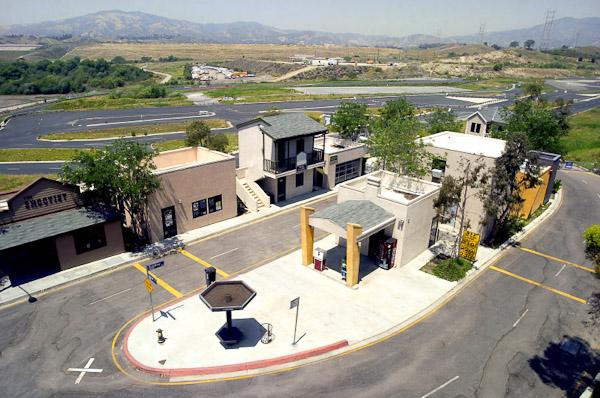
[Image: An otherwise only conceptually related photo by Steve Rowell shows the LAPD's Edward M. Davis Emergency Vehicle Operations Center & Tactics/Firearms Training Facility in Granada Hills, CA; courtesy of the Center for Land Use Intrepretation].
I was fascinated to read yesterday that a cyberwarfare training city is under construction, to be opened by March 2013, "a small-scale city located close by the New Jersey Turnpike complete with a bank, hospital, water tower, train system, electric power grid, and a coffee shop."
I envisioned whole empty streets and bank towers—suburban houses and replica transportation depots—sitting there in the rain whilst troops of code-wielding warriors hurl electromagnetic spells from laptops against elevator circuit boards, sump pumps, and garage doors, flooding basements, popping open underground gold vaults, and frying traffic lights, like some gonzo version of The Italian Job wed with the digital wizardry of a new sorcerer class, the "first-line cyber defenders" who will be trained in this place, our 21st-century Hogwarts along the freeway. Then they clean it all and start again tomorrow.
Alas. Although this, in many ways, is even more interesting, the entire "test city" truly is miniature: indeed, the whole thing "fits in a six by eight foot area and was created using miniature buildings and houses, [and] the underlying power control systems, hospital software, and other infrastructures are directly from the real world."
Nonetheless, this 6-x-8 surrogate urban world will be under near-constant microcosmic attack: "NetWars CyberCity participants, which include cyber warriors from the Department of Defense and other defenders within the U.S. Government, will be tasked with protecting the city's critical infrastructure and systems as they come under attack. Cyber warriors will be presented with potential real-world attacks; their job is to defend against them. Missions will include fending off attacks on the city's power company, hospital, water system and transportation services."
Which means, in the end, that this is really just an enlarged board game with an eye-catching press release—but there is still something compelling about the notion of an anointed patch of circuits and wifi routers, accepted as an adequate stand-in—an electromagnetic stunt double—for something like all of New York City, let alone the United States. A voodoo doll made of light, animated from within by packet switches, under constant surveillance in an invisible war.
(Via @pd_smith).
fabric | rblg
This blog is the survey website of fabric | ch - studio for architecture, interaction and research.
We curate and reblog articles, researches, writings, exhibitions and projects that we notice and find interesting during our everyday practice and readings.
Most articles concern the intertwined fields of architecture, territory, art, interaction design, thinking and science. From time to time, we also publish documentation about our own work and research, immersed among these related resources and inspirations.
This website is used by fabric | ch as archive, references and resources. It is shared with all those interested in the same topics as we are, in the hope that they will also find valuable references and content in it.
Quicksearch
Categories
Calendar
|
|
December '12 |
|
||||
| Mon | Tue | Wed | Thu | Fri | Sat | Sun |
| 1 | 2 | |||||
| 3 | 4 | 5 | 6 | 7 | 8 | 9 |
| 10 | 11 | 12 | 13 | 14 | 15 | 16 |
| 17 | 18 | 19 | 20 | 21 | 22 | 23 |
| 24 | 25 | 26 | 27 | 28 | 29 | 30 |
| 31 | ||||||
